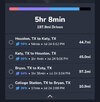M3P 2023, about 5k miles.
Topped off to 90% this morning, took the scenic route to work:

Topped off to 81% from 61% at work, headed to second work location:

Then realized that I have to drop of someone at the airport and drove as fast as I could back home. Then airport, then back home.
Work location 1 to work location 2, work location 2 to home, home to airport and airport to home shown below.

Arrived home with 10% just ticking to 9% as I pulled in the driveway.
Temperature ranged from 95 when I left to 104 at peak and 97 at return.
Figured this would help calm someone.
Topped off to 90% this morning, took the scenic route to work:
Topped off to 81% from 61% at work, headed to second work location:
Then realized that I have to drop of someone at the airport and drove as fast as I could back home. Then airport, then back home.
Work location 1 to work location 2, work location 2 to home, home to airport and airport to home shown below.
Arrived home with 10% just ticking to 9% as I pulled in the driveway.
Temperature ranged from 95 when I left to 104 at peak and 97 at return.
Figured this would help calm someone.





